1 - Andre Koch Torres Assis and Julio Akashi Hernandes, The Electric Field Outside Resistive Wires Carrying Steady Currents
Institute of Physics - State University of Campinas
13083-970 Campinas - SP - Brazil
E-mails: assis@ifi.unicamp.br - julioher@ifi.unicamp.br
Homepage: http://www.ifi.unicamp.br/~assis
<<This book is dedicated to the memory of Wilhelm Eduard Weber (1804-1891) in the 200th anniversary of his birth. He was one of the main pioneers in the subject developed here, the study of surface charges in resistive conductors carrying steady currents. We hope this book will help to make his fundamental work better known.>>
Contents
Acknowledgments
I Introduction
1 Main Questions and False Answers
1.1 Simple Questions
1.2 Charge Neutrality of the Resistive Wire
1.3 Magnetism as a Relativistic Effect
1.4 Weber's Electrodynamics
2 Reasons for the Existence of the External Electric Field
2.1 Bending a Wire
2.2 Continuity of the Tangential Component of the Electric
Field
3 Experiments
3.1 First Order Electric Field
3.2 Second Order Electric Field
II Straight Conductors
4 General Theorem
5 Wire of Circular Cross Section
5.1 Geometry of the Problem
5.2 Force due to Electrostatic Induction
5.3 Force Proportional to the Current
5.4 Force Proportional to the Square of the Current
5.5 Radial Hall Effect
5.6 Discussion
6 Coaxial Cable
6.1 Introduction
6.2 Potentials and Fields
6.3 The Symmetrical Case
6.4 The Asymmetrical Case
6.5 Discussion
7 Transmission Line
7.1 Introduction
7.2 Two-Wire Transmission Line
7.3 Discussion
8 Resistive Plates
8.1 Introduction
8.2 Single Plate
8.3 Two Parallel Plates
8.4 Four Parallel Plates
8.4.1 Opposite Potentials
8.4.2 Perfect Conductor Plate
9 Resistive Strip
9.1 The Problem
9.2 The Solution
9.3 Discussion
III Curved Conductors
10 Resistive Cylindrical Shell with Azimuthal Current
10.1 Geometry of the Problem
10.2 Potential and Electric Field
10.3 Surface Charge Densities
10.4 Lumped Resistor
11 Resistive Toroidal Conductor with Azimuthal Current
11.1 Introduction
11.2 Description of the Problem
11.3 General Solution
11.4 Particular Solution for a Steady Azimuthal Current
11.5 Electric Field and Surface Charges
11.6 Thin Toroid Approximation
11.7 Charged Toroid Without Current
11.8 Discussion
IV Open Questions
12 Future Perspectives
Appendices
A Wilhelm Weber and Surface Charges
B Gustav Kirchhoff and Surface Charges
<<The goal of this book is to analyze the potential
and electric field inside and outside resistive conductors carrying steady
currents. We also want to discuss the distribution of charges along the surface
of the conductors which generate this field. This is an important subject
which unfortunately has been neglected by most authors writing about electromagnetism.
Our aim is to present the solutions of the main simple cases which can be
solved analytically in order to show the most important properties of this
remarkable phenomenon. It is written for undergraduate and graduate students
of the following courses: physics, electrical engineering, mathematics, history
and philosophy of science. We hope that it will be utilized as a complementary
text in the courses of electromagnetism, electrical circuits, mathematical
methods of physics, history and philosophy of science. Our intention is to
help in the formation of a critical mind in the students and to deepen their
knowledge of this fundamental area of science. We begin showing that many
important authors maintained wrong points of view related to steady currents,
not only in the past but also in recent years. The list includes Maxwell,
Feynman (Nobel prize winner) and many others. In a sense this first topic
may be considered the most important of the book. Not only does it show that
classical electrodynamics is a lively subject in which there is still much
to be discovered, but it can also alert the readers of the mistakes repeated
in textbooks along the years related to the most simple questions. By realizing
this the readers should become more careful about the contents of many textbooks.
How many other mistakes or false statements can they contain? The readers
can also enhance their critical reasoning related to what they learn. Another
goal is to show that electrostatics and steady currents are intrinsically
connected subjects. The electric fields inside and outside the conductors
carrying dc currents are due to distributions of charges along their
surfaces, maintained by the batteries. This can bring an unity in the treatments
of textbooks related to the subject of electrostatics and steady currents,
contrary to what we find nowadays in most works. We begin considering in
general straight conductors of arbitrary cross-sections and a general theorem
related with their surface charges. Next we deal with a long straight conductor
of circular cross section. Then we treat a coaxial cable and a transmission
line (twin lead). In the sequence we deal with conducting planes and a straight
strip of finite width. In the second part we consider a long cylindrical shell
with azimuthal current and a toroidal conductor with steady azimuthal current.
Although much more complicated than the previous cases, this last situation
is extremely important as it can model a circuit bounded in a finite volume
of space carrying a closed dc current, like a resistive ring. By including
the analytical solutions of all these basic cases in a single work, our intention
is that this material can be utilized in the undergraduate and graduate courses
described above. Although the mathematical treatments and procedures are
more or less the same in all cases, they are presented in detail in each
geometry so that the chapters can be studied independently from one another.
It is then also easier to be incorporated in standard textbooks dealing with
electromagnetism and mathematical methods for scientists. Part of the subject
presented here was discussed in some textbooks and research papers previously.
It seems to us that the reason why it was not yet incorporated in most textbooks,
which even present false statements related to this topic, is that all these
simple cases were never put together in a coherent way. We hope to overcome
this limitation with this book. At the end of this work we present open questions
and future perspectives. In an Appendix we discuss an important work by Wilhelm
Weber where he presented a calculation related to the surface charges in
resistive conductors carrying a steady current, a remarkable piece of work
which unfortunately has been forgotten during all these years. We also discuss
Kirchhoff's works related to surface charges and the derivation by Weber and
Kirchhoff of the telegraphy equation. A great bibliography is included at
the end of the book. In this work we utilize the International System of
Units MKSA. When we define a concept we utilize º
as a symbol of definition. We represent by ![]() the force exerted by body j on i. When we say that a body is stationary or
moving with velocity
the force exerted by body j on i. When we say that a body is stationary or
moving with velocity ![]() , we are considering the laboratory as the frame of reference, unless stated
otherwise.>>
, we are considering the laboratory as the frame of reference, unless stated
otherwise.>>
2 - Avallon, l'uomo e il sacro, N. 52, 2003
Apocalisse - Segni e presagi della fine
Il Cerchio Iniziative Editoriali
Via Dell'Allodola, 8 - 47900 Rimini
ilcerchio@iper.net, http://www.ilcerchio.it
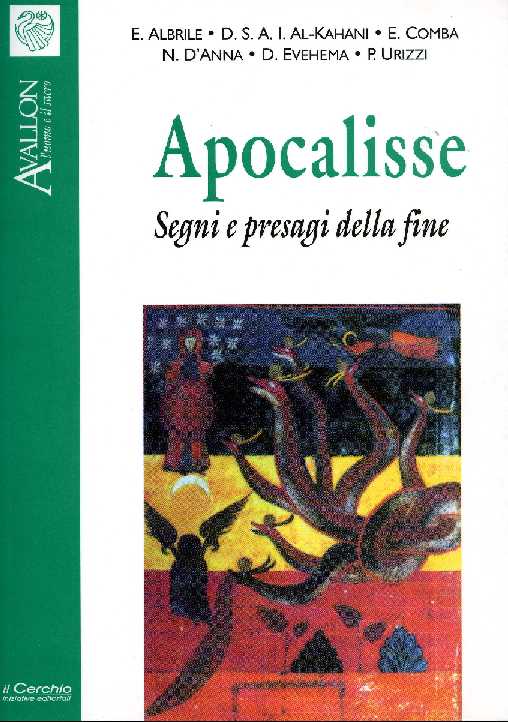
Nuccio D'Anna, Il Puer della IV egloga di Virgilio: il
messianismo pagano alla fine della Repubblica
Paolo Urizzi, Il Salvatore escatologico in ambito islamico:
l'Imam atteso e il Cristo della seconda venuta
Enrico Comba, La fine del mondo e la fine del tempo: la Ghost
Dance del 1890 tra gli Indiani Lakota
Dawud Sulayman Amar Ibn Al-Kahani, II ruolo dei Sabei nel
kalâm islamico
Ezio Albrile, Gnosi in Kurdistan. Apocalittica e sincretismo
iranico-mesopotamico tra gli Yezidi
Dan Evehema, La profezia degli indiani Hopi
Estratto del messaggio del capo spirituale all'umanità
<<Apocalisse, cioè rivelazione o disvelamento racconto di vicende umane che conducono la storia a compimenti drammatici, a rese dei conti che sconfiggeranno il male del mondo, ristabilendo il dominio divino sulla terra in una nuova era di letizia e concordia. Drammatico scenario di catastrofi e flagelli che purificheranno l'umanità in una ordalía finale. Suggestiva e terribile narrazione di rapimenti estatici, di visioni e profezie che interpretano segni e presagi, timori e desideri collettivi di riscatto in una vertigine pervasa da angeli vendicatori in lotta contro le potenze demoniache.>>
3 - Avallon, l'uomo e il sacro, N. 53, 2004
L'Impero - L'anima profonda dell'Europa
Il Cerchio Iniziative Editoriali
Via Dell'Allodola, 8 - 47900 Rimini
ilcerchio@iper.net, http://www.ilcerchio.it
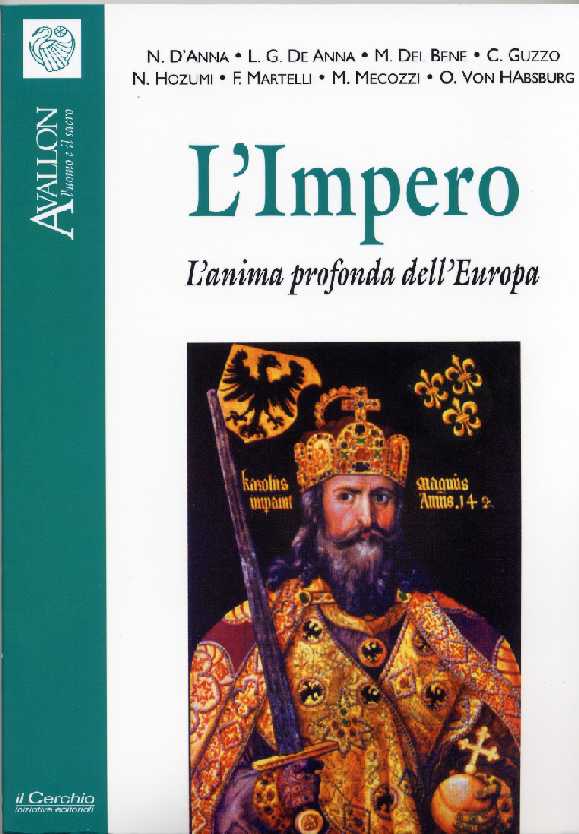
Nuccio D'anna, Alle radici dell'Imperium: gens
Iulia, Troiae lusus e sovranità
Cristian Guzzo, ROMA VICTRIX - La religiosità militare
delle legioni dalla Repubblica all'Impero
Luigi G. De Anna, La vocazione imperiale del Toson d'Oro
Fabio Martelli, Ideologia imperiale e correnti messianiche
alla vigilia della guerra dei Trent'anni
Marco Del Bene, Tradizione e modernità del sistema
imperiale nel Giappone moderno
Omaggio a Marguerite Yourcenar (a c.d.R.) SAECULUM AUREUM
- DISCIPLINA AUGUSTA
Maurizio Mecozzi, Federico II Imperatore
Otto Von Habsburg, "Europa Imperiale"
Nobushige Hozumi, La Casata imperiale nella Tradizione giapponese
<<Nella storia d'Europa e del resto del mondo l'impero è una idea che riunisce uomini e intenti sotto un emblema sovranazionale che si estende su etnie, lingue e religioni diverse. L'impero ha i suoi carismi, le proprie ritualità istituzionali, simboli di autorità e autorevolezza, riferimenti spirituali, religiosi e mitici, insegne, vesti, ornamenti, araldica, luoghi sacri e templi. La sua retorica è palese e intenzionale, facile da individuare e demitizzare: ma è altrettanto ammaliatrice e insidiosa e si ripropone in nuovi imperi e in nuove propagande, spesso autoritarie ma non autorevoli, in ideologie di dominio piuttosto che di governo, nella violenza piuttosto che nella forza.>>
4 - Antonino Drago, La riforma della dinamica secondo G.W. Leibniz
- Testi originali e loro interpretazione moderna
Hevelius Edizioni Scientifiche Italiane, Benevento, 2003
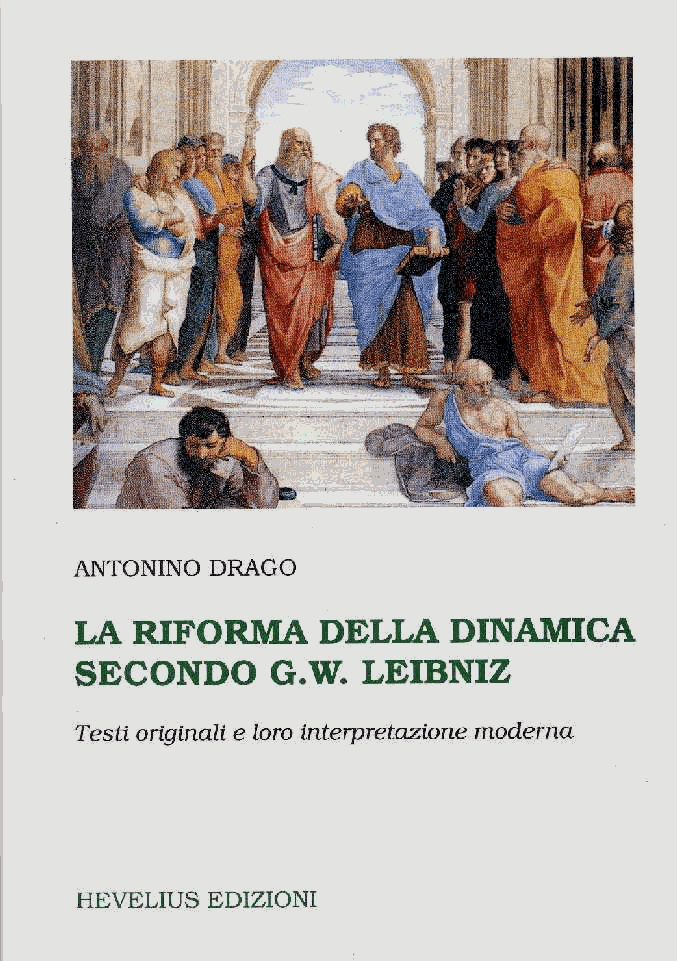
<<Si doveva cercare se i fenomeni naturali complessi non si potessero derivare da altri fenomeni noti e studiati. È infatti inutile assumere cause possibili al posto di quelle vere, quando le cause vere e certe ci stanno davanti agli occhi. Così io credo che sul mio esempio si potrebbero proporre alla ricerca cose più intelligenti: che in futuro la filosofia naturale venga trattata senza ipotesi immaginarie, ma presupponendo cause tali la cui realtà effettuale è ben accertata nella natura. Nessuno infatti, per quel ch'io sappia, ha cercato di spiegare la congerie delle particolarità movendo da pochi fenomeni generali; nel che peraltro consiste il vero procedimento dimostrativo della fisica.>> (G.W. Leibniz)
<<Per la prima volta viene offerta la traduzione in italiano di un gruppo molto significativo di studi di Leibniz sulla meccanica, da lui scritti dopo il 1690; essi comprendono in maniera essenziale la sua polemica con i cartesiani che diverrà nota come la polemica della vis viva e che farà discutere per un secolo i massimi teorici della fisica. Gli scritti sono stati accuratamente commentati (e in parte ridotti), in modo da renderli per la prima volta facilmente comprensibili ad un lettore di cultura media; inoltre sono state inserite tra parentesi quadre le semplici formule matematiche che traducono i concetti leibniziani, in modo da assicurare la piena comprensione dei testi anche a coloro che preferiscono il linguaggio formale. Questi testi sono sufficienti per chiarire la polemica della vis viva e, cosa ancor più importante, per ricostruire la "Riforma della dinamica" di Leibniz. Al contrario di come la giudicò B. Russell ("un cumulo di confusione"), essa risulta una teoria coerente, ancorché incompleta. Essa può essere considerata come l'inizio sostanzioso di una rifondazione della meccanica, completamente alternativa a quella di Newton. Data la enorme influenza avuta da Newton per i suoi grandi successi, essa poi è stata trascurata o equivocata con un atteggiamento ostinatamente metafisico di Leibniz - esattamente il contrario dell'atteggiamento qui manifestato da Leibniz. La alternativa della sua meccanica riguarda non solo la diversa concezione dei concetti di spazio e tempo, ma anche i concetti fondanti - l'energia invece che la forza -, l'esclusione dell'analisi infinitesimale dai fondamenti della teoria, la organizzazione basata su un problema invece che su dei principi assiomi. Di straordinaria importanza la sua maniera di ragionare per la prima volta per simmetrie in fisica teorica, cioè secondo trasformazioni sul sistema in esame. La sua meccanica però appare limitata dalla mancanza della formula del principio dei lavori virtuali, data da J. Bernoulli solo dopo la morte di Leibniz. Il compimento del programma di Leibniz sulla meccanica è avvenuto quasi un secolo dopo con la teoria di Lazare Carnot (1783), la quale è stata riscoperta nel 1971 ed è stata rivalutata in questi ultimi anni (ed. it, CUEN 1994). In più, i testi di Leibniz risultano adatti ad una proposta didattica innovativa; per la prima volta essi propongono un preciso e importante argomento di studio sia agli insegnanti di Fisica che agli insegnanti di Filosofia delle scuole Superiori; attraverso di esso questi insegnanti possono ricostituire quel legame tra le due materie che oggigiorno è spezzato. L'insegnante di Fisica può comprendere le assunzioni filosofiche che stanno alla base della meccanica di Leibniz e per contrasto, quelle di Newton; mentre l'insegnante di Filosofia può comprendere quali concetti fondamentali della Fisica danno una precisa alternativa alla scienza che ha dominato per tre secoli.>>
INDICE
INTRODUZIONE
1. IL PROGRAMMA DELL'OPERA
1.1 II problema dell'interpretazione del pensiero di Leibniz
in meccanica
1.2 II precedente lavoro interpretativo degli storici e dei
filosofi della scienza
1.3 Una nuova visione
1.4 L'indirizzo di lavoro
1.5 I testi presentati
2. LA MECCANICA DI LEIBNIZ RICOSTRUITA COME COERENTE ALTERNATIVA
ALLA MECCANICA DI NEWTON
2.1 II metodo di presentazione
2.2 II programma di Leibniz per una alternativa alla meccanica
di Newton
2.3 Quale architettura della teoria fisica?
2.4 Due grandi principi che distinguono due tipi di logiche
2.5 Un principio fisico generale
2.6 La interazione: "Causa aequat effectum"
2.7 Relatività di moto, spazio e tempo
2.8 Fondamenti della dinamica. La scelta di una matematica
semplice
2.9 Teoria dell'urto dei corpi
2.10 Le conservazioni
2.11 Teoria dei corpi pesanti
3. LA MECCANICA DI LEIBNIZ NELLA STORIA DELLA FISICA
3.1 La polemica di Leibniz con i Cartesiani sulla vis viva
3.2 L'introduzione concettuale delle simmetrie in fisica teorica
3.3 Valutazione della meccanica di Leibniz alla luce della
meccanica di L. Carnot
3.4 Ricostruzione sintetica della dinamica di Leibniz
3.5 La alternativa alla meccanica di Newton
3.6 Le tappe della costruzione della meccanica di Leibniz-L.
Carnot
3.7 La Scientia Generalis o Scienza delle scienze di
Leibniz
3.8 Conclusioni
4. PROPOSTE PER LA DIDATTICA DELLA FISICA E DELLA FILOSOFIA
NELLE SCUOLE SUPERIORI
4.1 Una proposta modesta, indirizzata agli insegnanti di
Fisica che trasmettono un elenco di tecniche di Fisica
4.2 Una proposta di livello superiore per gli insegnanti di
Fisica e per gli insegnanti di Filosofia
5. NOTE FILOLOGICHE. VOCABOLARIO DELLE NOZIONI UTILIZZATE
DA LEIBNIZ
5.1 Note filologiche (con F. Piro)
5.2 Vocabolario delle parole usate da Leibniz
5.3 Principali opere di Leibniz sulla dinamica
Note
BIBLIOGRAFIA
I TESTI
DALLA LETTERA DI LEIBNIZ AD HONORATUS FABRI DEL 1677
BREVE DIMOSTRAZIONE DELL'ERRORE MEMORABILE DI CARTESIO (1686)
SAGGIO DI DINAMICA (1692)
Presentazione dell'opera
Un primo sguardo all'opera
Descrizione sintetica dell'opera
II problema cruciale: l'organizzazione della teoria
La serie delle frasi doppiamente negate
La versione didattica e ridotta
G.W. LEIBNIZ: ESSAY DE DYNAMIQUE
SAGGIO INTRODUTTIVO ALLA DINAMICA (1695)
Nota introduttiva al Saggio del 1695 (di F. Piro)
G.W. LEIBNIZ: SPECIMEN DYNAMICUM
SAGGIO DI DINAMICA SULLE LEGGI DEL MOTO (1698)
Introduzione
G.W. LEIBNIZ: ESSAY DE DYNAMIQUE SUR LES LOIS DU MOUVEMENT
Note
5 - Alessio Follieri, La nuova razionalità - Tra scienza,
filosofia e teologia
Editore Pascale, Roma, 2004
viale Alessandrino 133/B2, 00172 Roma (tel. 06/24301774)
http://www.mariomichelepascale.net
(gli utenti interessati possono prenotare direttamente le copie presso l'editore)
<<Se non vi fosse stata alcun'esigenza moderna di conoscere la realtà che ci circonda, compresi noi stessi, non avrei scritto questo libro. Essendo la conoscenza stessa, un bene che ritengo libero e soprattutto per tutti, ho completato la stesura di questo lavoro nel modo più semplice possibile, sviluppando concetti essenziali, dove il lettore ha il più ampio respiro per completare egli stesso le proprie riflessioni. Onestamente, se fossi stato un ottimo scienziato, non avrei pubblicato questo lavoro, così come se fossi stato un convinto filosofo o teologo. E' questo per molti versi il senso della nuova razionalità, essere semplicemente individui nell'Universo e non concedere alcun atto di presunzione nel credere che una dottrina costituita da leggi e regole sia in grado di afferrarne il significato più intimo.>> (Dalla Prefazione dell'autore).
Introduzione
Parte I - Come conosciamo il mondo
Capitolo 1 - Razionalità e conoscenza
Razionalità precostituita
Capitolo 2 - Scienza, filosofia e teologia
Filosofia: nasce la logica
Teologia
La scienza
Limiti, congetture e confutazioni
Metodo scientifico e rigore logico matematico
Kurt Godel e l'incompletezza matematica
Capitolo 3 - Quale verità?
Ritorno alla filosofia
Parte II - Cosa conosciamo del mondo
Capitolo 4 - Il Big Bang
Universo infinito; Universo in espansione
Da Einstein alla Teoria del Big Bang
Capitolo 5 - La teoria quantistica
Un piccolo Universo, Atomi e Particelle
La Teoria Quantistica, una nuova sorprendente realtà
Capitolo 6 - Le forze fondamentali della natura e la teoria del "tutto"
La Grande Teoria Unificata
Parte III - Oltre i nostri orizzonti
Capitolo 7 - Nuove straordinarie implicazioni
Il dilemma del Big Bang
"Prima del Big Bang"
Capitolo 8 - Il segreto dell'informazione
Il mondo dei quanti
Questione d'informazione
Il paradosso EPR, esiste un qualcosa di straordinario
La massa mancante
Capitolo 9 - Evoluzione
Evoluzione
Determinismo o Indeterminismo?
Il dilemma del tempo
Capitolo 10 - Vita e intelligenza
Dal profondo delle stelle
Una grande complessità
Il cervello
La meccanica quantistica, invade lo studio della materia vivente
Capitolo 11 - Dal Big Bang alla materia vivente - Il nocciolo dell'evoluzione
Nuovi muri, nuovi orizzonti
Interazione dal piccolo, al grande
Il nostro contenuto interiore
Interazione nel tempo
Origine
Evoluzione del sistema umano tra etica e libero arbitrio
Parte IV - Una porta verso l'infinito
Capitolo 12 - Nuovi fenomeni
Fenomeno extraterrestre e la disinformazione
Questione di Razionalità
Teoria probabilistica sull'esistenza extraterrestre
Una nuova entusiasmante interpretazione
Congetture e contraddizioni
Capitolo 13 - Dalle guarigioni ai casi di pre morte
Né principio né fine
Oltre la vita
Perché non esistono strumenti?
Conclusioni
6 - Daniel Janik, A Neurobiological Theory and Method of Language
Acquisition
Dan Janik, MD PhD (FACPM*, FAAIM*)
Intercultural Communications College
1601 Kapiolani Blvd #1000
Honolulu, HI 96814 USA
Phone 808-946-2445 - FAX 808-946-2231
Email djanik@icchawaii.edu
Personal webpage http://homepage.mac.com/dannyjan
* FACPM - Fellow of the American College of Preventive Medicine
* FAAIM - Fellow of the American Association of Integrative Medicine
http://home.t-online.de/home/LINCOM.EUROPA/
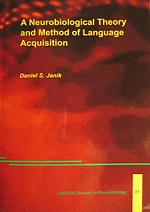
<<This theory and method are broadly applicable to education, teaching and learning, and represent the beginning of a radical shift in educational theory, application and the business of education.
A new theory of learning is posited, based on contemporary clinical and experimental neurobiological data on effective traumatic learning. Interesting linguistic exegeses of first and second language acquisition under such a theory are examined and their implications discussed. A list of methodological tenets is derived, applied and demonstrated in limited fashion in a traditional, educational, classroom setting. The neurobiological method is presented along with derivisional hypotheses that, with further research, might lend it further support and provide new avenues of insight into not only into the fundamental nature of first and especially second language acquisition, but learning and teaching in general.>>
PROBLEMS
Chapter 1: INTRODUCTION
Chapter 2: THE NEED FOR A NEW LEARNING METHODOLOGY
CLINICAL AND EMPIRICAL EXPERIENCE
Chapter 3: TRAUMATIC LEARNING
Chapter 4: COGNITIVE LEARNING
EXPERIMENTAL EVIDENCE
Chapter 5: NON-IMAGING STUDIES
Chapter 6: IMAGING STUDIES
NEUROBIOLOGICAL LEARNING
Chapter 7: NEURO-ANATOMICAL BASES
Chapter 8: NEUROBIOLOGICAL FOUNDATIONS
A NEUROBIOLOGICAL THEORY OF LANGUAGE ACQUISITION
Chapter 9: LANGUAGE ACQUISITION
Chapter 10: SECOND LANGUAGE ACQUISITION
Chapter 11: ACQUISITION OF ENGLISH AS A SUBSEQUENT LANGUAGE
THE NEUROBIOLOGICAL METHOD
Chapter 12: THE NEUROBIOLOGICAL METHOD
Chapter 13: APPLICATION
Chapter 14: SUMMARY, CONCLUSIONS, AND MUSINGS
Acknowledgments - Bibliography - Index
7 - Joseph Lévy, From Galileo to Lorentz... and beyond
- Principles of a fundamental theory of space and time
Apeiron, Montreal, 2003
vi + 94 pp. (softcover) - ISBN 0-9732911-1-7
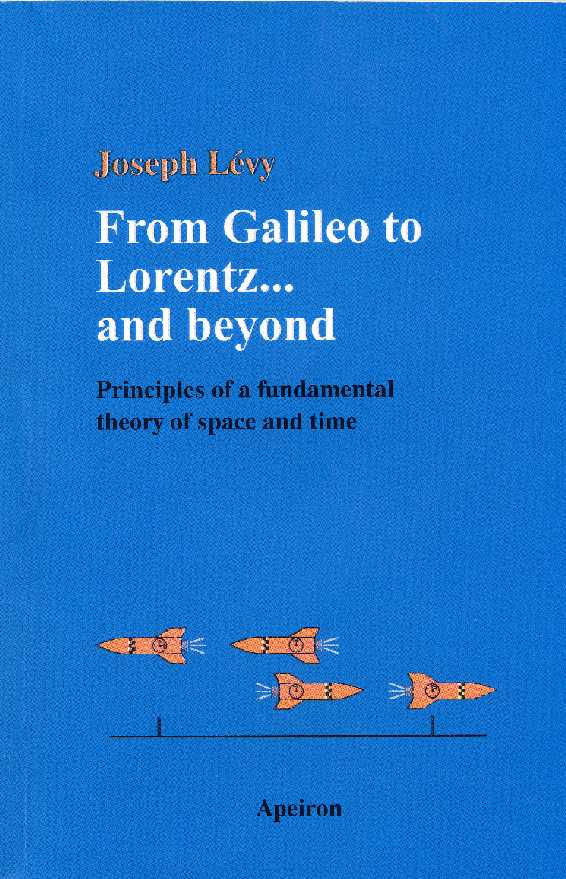
<<Assuming the existence of a fundamental aether frame and the anisotropy of the one-way speed of light in the Earth frame, two facts supported by theoretical arguments (see chapters 2 and 8) and repeatedly confirmed today by experiment, J. Lévy derives a set of space-time transformations. These are demonstrated to be consistent, in that:
- They reduce to the Lorentz-Poincaré transformations when one of the two frames under consideration is the fundamental frame.
- They show how systematic errors of measurement due to Lorentz contraction, clock retardation, and unreliable clock synchronization explain why the speed of light is paradoxically always found to be constant, even though it is actually anisotropic.
- Conventional relativity theory leads to inconsistencies that are removed by the present theory.
The implications for fundamental physics are shown to be wide reaching.>>
Preface: This book draws conclusions from lectures given by the author at various conferences, and from several articles published in collections of essays on relativity theory. Some of the ideas presented here arise from these earlier works, though they may not have been explicitly stated before. The book is inspired in part by the works of Simon Prokhovnik, which represent a fundamental step in the understanding of the theories of space and time. Nevertheless, the reader will appreciate that, beyond a certain point, it departs from Prokhovnik's views. The reasons for this new course will be explained in detail. We leave the result to the reader's judgment. The manuscript presents a number of unconventional ideas. We have done our best to refute them, but in the end we find ourselves obliged to accept them as factual. Although we have criticized some of their views, we would like to pay homage to all our predecessors, without whom this manuscript could have not seen the light of day, in particular to Lorentz, Einstein and Poincaré.
Table of Contents
Preface
Acknowledgements
Foreword
Steps in the development
of the new conception
Introduction
Difficulties with
Orthodox Relativity Theory
On light-speed
invariance
On the relativity
of simultaneity
On the relativity
principle
Distance, velocity
and time
Some Useful Concepts
Extended Space-Time Transformations
Introduction
Derivation of
extended space-time transformations
Consistency of
the transformations
Conclusion
Appendix 1
Appendix 2
Inertial Transformations Derived from Galilean Transformations
Prologue
Inertial transformations
between the aether frame and other inertial frames
Compatibility of
the Galilean law of composition of velocities with a limit velocity
Inertial transformations
in the general case
Arguments in Favour of Lorentz-Fitzgerald Contraction
Introduction
Present-day arguments
for Lorentz contraction
Implications for Fundamental Physics
The relativity
principle
Mass-energy conservation
Principle of inertia
Conservation of
momentum
Mass-energy equivalence
Variation of mass
with speed
Invariance of
the one-way speed of light
Twin paradox
Relativity of
time
Relativity of
simultaneity
Minkowski space-time
Length contraction
Mass and Energy in the Fundamental Aether Theory
Demonstration of
E= mC2 without relativistic arguments
Variation of mass
with speed
Variation of mass
with speed in relativity and in the fundamental aether theory
The question of
reciprocity
Possible measurement
of the absolute speed of an inertial system
Conservation of
energy
Synchronization Procedures and Light Velocity
Measuring the
speed of light with one or two clocks by the Einstein-Poincaré procedure
Measuring the
speed of light by the slow clock transport procedure
References
Index
Joseph Lévy completed his Doctoral degree at the University of Paris VI and has published numerous papers in different fields of physics in international journals. He is now engaged in a study of relativity from a critical point of view. Since 1994 he has been a regular participant in the international conference "Physics Interpretations of Relativity Theory" held every two years at Imperial College of the University of London, which is sponsored by the British Society for the Philosophy of Science. He was also a member of the organizing committee of the international conference "Geometrization of Physics", Kazan State University, Russia.
8 - Francesco Vitale, Accampamenti romani nel Veneto
CLEUP, Coop. Libraria Editrice Università di Padova
Via G. Belzoni, 118/3 - Padova (Tel. 049-650261)
http://www.cleup.it
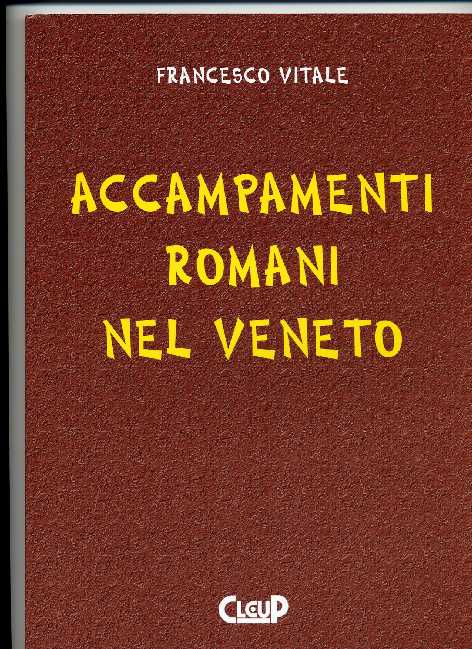
<<Nel Veneto si possono ancora oggi ammirare alcuni manufatti costituiti da tumuli e da imponenti cinte arginate, come quelle di Veronella Alta (VR), e di Castello di Gòdego (TV). I reperti trovati nelle loro vicinanze hanno fatto pensare a costruzioni appartenenti all'Età del Bronzo; tuttavia, i motivi che avrebbero portato in epoca preistorica all'edificazione di fortificazioni di enormi dimensioni non sono chiari e, tra gli studiosi, molte sono le perplessità persino sull'età che è stata loro attribuita. L'Autore dimostra rigorosamente - avvalendosi anche di altre discipline, quali la tecnica delle costruzioni, la metrologia antica e l'archeoastronomia - che i manufatti sono resti di accampamenti costruiti dai Romani verso la fine del II sec. a.C.. Il testo, che offre una dettagliata descrizione delle armi e delle tecniche militari usate in quel tempo, contiene anche uno studio idrografico sugli antichi corsi seguiti dall'Adige in epoca preistorica e romana.>>
Prefazione
II terrapieno di Veronella Alta
I documenti storici
La struttura dell'accampamento romano
Ricerca degli antichi corsi dell'Adige
L'enigma della "Rotta della Cucca"
Le Motte di Castello di Gòdego: descrizione del sito
Le ipotesi avanzate sull'utilizzazione del sito
Le obiezioni alle ipotesi proposte
Le ipotesi archeoastronomiche
La nostra spiegazione sull'origine e la funzione delle Motte
Ultime considerazioni sulle fortificazioni prese in esame
Altre fortificazioni di probabile origine romana
Bibliografia
Documentazione fotografica
* * * * *
Notiziario del Centro per la Diffusione della Teoria delle Apparenze

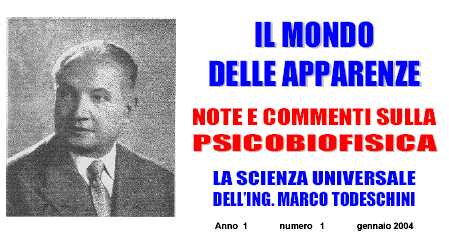
Editoriale
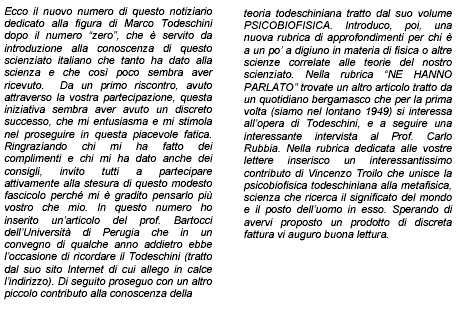
Subject: ASSOCIAZIONE ACNR
Date: Thu, 18 Mar 2004 13:00:52 +0100 (CET)
From: Fiorenzo Zampieri <zampierifiorenzo@yahoo.it>
Carissimi amiche/amici
Finalmente la bella notizia. E' attivo il sito della nostra Associazione Culturale Nuova Ricerca (ACNR), all'indirizzo:
Siete tutti invitati a visitarlo e a partecipare attivamente alla sua formazione mediante suggerimenti, interventi, contributi e quant'altro. Sarà estremamente gradita la vostra eventuale richiesta di adesione (gratuita) alla stessa in modo da formare un gruppo oltre che qualitativamente anche quantitativamente importante. Nel sito troverete tutte le istruzioni del caso.
Un abbraccio fraterno.
Fiorenzo Zampieri
* * * * *
Subject: Le novità di Giugno.
Date: Thu, 1 Jul 2004 02:17:57 +0200
From: "Riflessioni.it Newsletter" <news@riflessioni.it>
Newsletter mensile di www.riflessioni.it che vi aggiorna sulle novità del sito.
Le novità di Giugno sono state:
---- Tra i Testi: http://www.riflessioni.it/testi/index.htm
"Sull'amicizia" di Epitteto, da "Le diatribe e frammenti".
---- Nell'Angolo Filosofico: http://www.riflessioni.it/angolo_filosofico/index.htm
"La dea Iside: la Grande Dama" di Ermando Danese.
---- Tra le Esperienze di Vita: http://www.riflessioni.it/esperienze/index.htm
"Telericordi" a cura di Davide Riccio.
---- Tra le LettereOnLine: http://www.riflessioni.it/lettereonline/index.htm
"Tu… mi regali un sorriso?" di Pietro Mastandrea.
"Il solidarismo" di Fausto Sangiorgi.
"Omertà non sta a Solidarietà" di Vincenzo Andraous.
---- Nella rubrica: Prosa & Poesia: http://www.riflessioni.it/prosa_poesia/index.htm
"L'amicizia" di autore anonimo.
Poesia di J. Krishnamurti.
Grazie per l'attenzione, Ivo Nardi
* * * * *
Added on 12th October, 2010
We receive only today the sad news of Paul Marmet's death, which
occurred 5 years ago.
All people wishing information about his scientific work, could
address their request to: paul@marmet.org
Subject: --- New papers
Date: Thu, 03 Jun 2004 15:45:41 -0400
From: Paul Marmet
You might be interested to see new papers about the Michelson-Morley Experiment, and the Lorentz transformation.
"The Overlooked Phenomena in the Michelson-Morley Experiment" is on the Web at:
http://www.newtonphysics.on.ca/michelson/michelson.html
Also I have another new paper "The Collapse of the Lorentz Transformation" at:
http://www.newtonphysics.on.ca/lorentz/lorentz.html
Regards, Paul Marmet
* * * * *
Subject: Vol 6-3 of the Journal of Theoretics
Date: Tue, 08 Jun 2004 18:44:32 -0500
From: "Journal of Theoretics" <mail@journaloftheoretics.com>
**** New Original Articles of the Journal of Theoretics ****
June/July 2004 Vol.6-3 http://www.journaloftheoretics.com
Original Peer Reviewed Articles
- "Does Time Really Exist as a Fourth Dimension of Space?" by Dott. Amrit
Sorli, Dott. Kusum Sorli
- "Space and Matter" by Dott. Ing. Amrit Sorli
- "Proving that Space Density Theory is Different and More Complete than
Spacetime" by James P. Siepmann
- "A New Equation of Light Trajectory" by Dipl. Ing. Andrija S. Radovic
- "Discovery of a Solution to the Heisenberg Uncertainty Principle Conflict
Between Relativistic Intrinsic Spin and Classical Mechanics" by Warren York
- "The Meaning of Mass" by A.C.V. Ceapa
- "Determining Unification Energies of Fermion's in Zero Space" by Lance
Fraser Christian
- "Refining the Diatomic Model for the Vaporization of Liquids" by G. V.
Calder
- Guest Commentary: "Dense Space and Its Implications" by Piers Newberry
Comments on:
- "Einstein 1, Quantum Gravity 0"?
- A Space Density Problem
- The Truth about Smoking
- About the LightClock
- Gravity and Spacetime
Editorial: "What is a Photon?"
Also a listing of Conferences, Awards, & Grants of interest.
Recommended Links, and more....
Subject: Vol.6-4 through Vol.6-6 of the Journal of Theoretics
Date: Sun, 01 Aug 2004 08:41:55 -0500
From: "Journal of Theoretics" <mail@journaloftheoretics.com>
**** New Original Articles of the Journal of Theoretics ****
Vol.6-4 August 2, 2004
"A P-brane Solution to Three Cosmological Puzzles" by Dr. Paul Karl Hoiland
"Energy-based Model to Contract the Riemann Curvature Tensor" by Ari Vepsäläinen
"Global Comprehensive Theory" by Zdravko Carev, Dobromir Bonacin
"Updating Panofsky’s Views on Distant Matter in Physics" by Jorge Guala-Valverde
"Thermo-Gravitational Equilibrium" by Giuseppe Guzzetta
"The Relativistic Velocity Addition Law through Special Relativity" by Bernhard
Rothenstein, Ioan Zaharie
Guest Commentary: "From Space-time to Space" by Amrit Sorli, Kusum Sorli
Vol.6-5 October 4, 2004
"Interaction Space and General Relativity" by Ali Riza Sahin
"Decay and Spin are the Foundation of Physics" by Guoyou Huang
"Unification of Newtonian Dynamics and General Relativity in Cosmology with
Constants Confirmed" by Guoyou Huang
"The Generalised Mass-Energy Equation deltaE = Ac2deltaM; its applications
in Cosmology" by Ajay Sharma
"The Gravity as a Longitudinal Field" by Costinel Lepadatu,Serban Lepadatu
"Viscosity and Cohesion Pressure" by Zeljko Prebeg
Guest Commentary: "Physical Space, Entropy And Life" by Amrit Sorli, Kusum Sorli
Vol.6-6 December 6, 2004 [Final Issue]
"Multi Foci Closed Curves by Mohd. Javed Khilji
"Antiquanta Discovered by V.N.Strel’tsov
"Relativity, Quantum Mechanics and Classical Physics Evidence for a close
Link between the Three Theories by Jean-Louis Tane
"The Motion and Structure of Matter under Universal Magnetism by Guoyou HUANG
"Memory Process and the Function of Sleep by Jie Zhang, Ph D.
Guest Commentary "Cosmology without Special Relativity Theory" by Hans J. Zweig, PhD
------------------------------------------------------------------
Also Comments and Editorial Sections for each issue.
------------------------------------------------------------------
Note: Since Vol.6-6 is our last issue before the Journal of Theoretics goes into stasis, this will be our last mailing. Please keep the above information about the remaining issues.
------------------------------------------------------------------
ISSN: 1529-3548 - The Journal of Theoretics is a 501c3 nonprofit organization.
*********** http://www.journaloftheoretics.com
************
* * * * *
Subject: Circolare n.° 122
Date: Wed, 28 Jul 2004 23:24:39 +0200 (CEST)
From: Centro Studi La Runa <centrostudilaruna@libero.it>
[...] Negli ultimi tempi sul sito del Centro Studi La Runa sono stati pubblicati numerosi nuovi articoli.
http://www.centrostudilaruna.it
Ne segnaliamo alcuni:
Claudio Mutti, Il Gotteskampf di Johann von Leers (prima parte),
www.centrostudilaruna.it/johannvonleers.html
Dario Giansanti, Le invasioni di Ériu (prima parte),
www.centrostudilaruna.it/invasionidieriuprimaparte.html
Marco Iacona, Agli antipodi del razionalismo,
www.centrostudilaruna.it/evolarazionalismo.html
Claudio Mutti, Evola e Nasser,
www.centrostudilaruna.it/evolaenasser.html
Gianfranco de Turris, Evola trent'anni dopo,
www.centrostudilaruna.it/evolatrentannidopo.html
Alfonso Piscitelli, Il sorriso di Hermes che vela e disvela,
www.centrostudilaruna.it/sorrisodihermes.html
Alberto Lombardo, L'immaginario alpino raccolto e catalogato,
www.centrostudilaruna.it/tersiliagattochanusagheleggendealpi.html
Associazione Culturale Identità e Tradizione: L'etno-nazionalismo
e l'ideologia völkisch,
www.centrostudilaruna.it/etnonazionalismoideologiavoelkisch.html
* * * * *
Subject: 21st Century Website Updated
Date: Mon, 2 Aug 2004 15:50:00 -0400
From: "21st Century Science" <editorial@21stcenturysciencetech.com>
Dear 21st Century Reader:
The contents page for the Summer 2004 issue is now posted.
http://www.21stcenturysciencetech.com/current.html
Sincerely, Marjorie Mazel Hecht, Managing Editor
Segnalazioni
1 - Si segnala che nella presentazione del Dr. Alessandro Moretti al saggio di Eulero "De Causa Gravitatis", apparso nel N. 1 di Episteme , è stato omesso un doveroso riferimento al "Kommentar zu einer Schrift Eulers über die Schwerkraft", scritto dal Dr. Andreas Kleinert, del Dipartimento di Fisica dell'Università di Halle-Wittenberg (il commento si trova all'interno dell'introduzione al Vol. 31, Seconda serie, Opera mechanica et astronomica - Commentationes Mechanicae et Astronomicae ad Physicam Cosmicam Pertinentes, edidit Eric J. Aiton, appendicem addidit Andreas Kleinert, pp. LXXXVII - XCIII, dell'Opera Omnia di Eulero, Auctoritate et Impensis Academiae Scientiarum Naturalium Helveticae, Basilea, 1996). In esso infatti il Dr. Kleinert discute attraverso quali elementi si debba attribuire effettivamente al grande matematico svizzero l'articolo in questione, che ricordiamo fu pubblicato anonimo.
2 - Si avverte che nell'articolo di Umberto Bartocci "La vera identità di Cristoforo Colombo - Osservazioni e congetture", apparso in Episteme N. 6, viene attribuita infine, tra i ringraziamenti, la paternità del libro Sulla piacentinità di Cristoforo Colombo al trisnonno Bernardo Pallastrelli del Dott. Pier Lorenzo Ranieri Tenti, menzionato per questa e altre importanti informazioni. Orbene, lasciando da parte la questione degli stretti legami tra colui che risulta l'autore del testo citato e il Pallastrelli, lo studio in oggetto si deve invece al Prof. Luigi Ambiveri, del quale è nota anche una dissertazione letta nella sala municipale del Comune di Bettola il giorno 24 marzo 1889, sul tema "Del luogo di nascita di Cristoforo Colombo" (F. Solari, Piacenza, 1889). Con l'occasione il Dott. Ranieri Tenti, a cui rinnoviamo i ringraziamenti per la cortese attenzione e collaborazione, ci notifica pure un'eventuale ulteriore conferma dell'ipotesi illustrata nell'articolo sopra riportato. Nel Libro III (Cap. XXII, p. 93) dell'opera Geographiae et hydrographiae reformatae libri XII (Bologna, 1661) dell'astronomo gesuita Giovanni Battista Riccioli (Ferrara, 1598 - Bologna, 1671; fu docente presso le università di Parma e Bologna) si trova la seguente affermazione: <<Christophorus Columbus ex Pelestrella stirpe placentina oriundus et postea Liguriae incola>>, la cui importanza per i fini accennati non sfuggirà certo agli interessati all'ancora oscuro "caso Colombo".
3 - Da Bruno d'Ausser Berrau riceviamo la segnalazione di alcune necessarie correzioni della Nota N. 59 del suo "Mysteria Latomorum - Uno studio sullo scisma massonico del 1717 e su alcuni aspetti generali di quell'Istituzione", pubblicato su Episteme N. 2. Presentiamo qui di seguito integralmente la nota in oggetto, così come essa viene ad essere costituita dopo le modifiche:
59 La prima Loggia di questa filiazione sembra sia stata fondata
nel 1728 a Madrid (la "French Arms"), seguono poi nel 1732 Parigi,
nel 1733 Valenciennes e Château d'Aubigny nel 1734. Per l'Italia, la
situazione è assai diversa: la data di riferimento è il 1732
ed il luogo Firenze anche se sembra ormai accertato che si debba risalire
a data precedente ma di difficile precisazione. L'ambiente in cui la Loggia
sorse è stato sicuramente quello anglofono già allora assai
presente in città ma, a differenza dell'agnazione modern delle
altre proiezioni overseas, in questo caso l'iniziativa dovrebbe essere
attribuita alla massoneria irlandese i cui rituali molto "ortodossi" riconducono
all'area degli antients. Nelle citazioni di tale gruppo il più
frequente riferimento è alla persona di Sir Horace Mann ed il motivo
è da ricercarsi soprattutto nel di lui rilevante ruolo sociale in
quanto ministro plenipotenziario della corte di San Giacomo presso il Granducato.
Nella Loggia c'era quel Tommaso Crudeli, dottore in lettere e poeta, che
ebbe poi, proprio per quest'appartenenza, a subire un famoso processo inquisitoriale.
Tale Loggia sotto il titolo di "Sir Horace Mann, 1732" è ancor
oggi presente e, nell'almanacco massonico internazionale List of Lodges
, è segnalata come <<a English speaking Lodge>>
. Sempre in Toscana, a Livorno (Leghorn), sede al tempo di due importanti
comunità inglesi e scozzesi, è accertata la presenza, in Via
Grande, di ben quattro Logge equamente divise tra le due correnti dei moderni
e degli antichi.
Necrologi
Episteme si associa al cordoglio per la scomparsa del Dott. Alessandro D'Alessandro, di Parma, sostenitore della rivista sin dai suoi esordi, e del Prof. Stevan Dedijer, che collaborò al successo del N. 2 con un articolo fuori dall'ordinario. Il loro ricordo resterà nei nostri cuori.